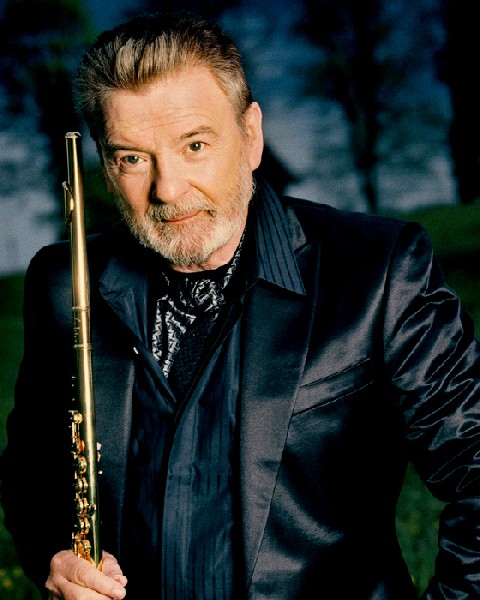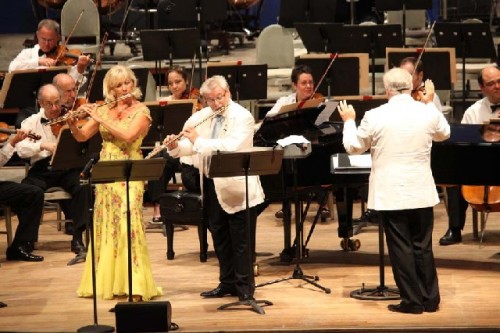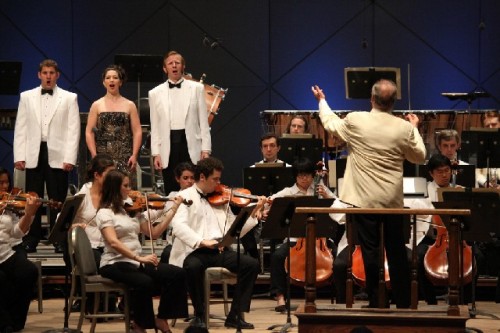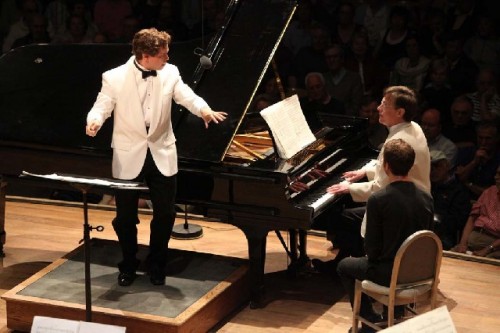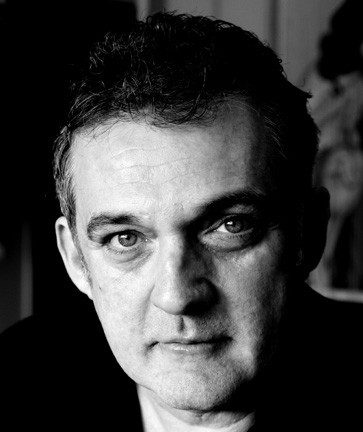Tanglewood: Sir James Galway, De Burgos' All Stravinsky
The Guns of August
By: Charles Giuliano - Aug 04, 2009
As July enters the record books in all its misery we hope for better weather and music under the stars as we begin the August home stretch of the Tanglewood Musical Festival. On good nights it seems that folks head for the lawn in droves. They have been too few so nobody wants to miss out on spreading the blankets, breaking out the cheese and crackers, and popping the Dom Perignon.
Last night a friend reported that it was her fifth straight night at Tanglewood. Talk about dedication. As I mentioned to her we have all winter and miles to go before we sleep.
It promises to be a spectacular week and, good grief, it's a bright sunny day.
Tomorrow the Mark Morris Dance Company prances on stage at Ozawa Hall (August 5 and 6). We sat behind him last week for Don Giovanni. The Morris dates have been moved to mid season this year. There will be the additional delight that the company will be joined by Yo Yo Ma, Colin Jacobsen, and Emmanuel Ax. There will be a world premiere of a piece set to the Ives Trio for piano, violin and cello.
From August 6 to 8 there will be the annual Tanglewood Wine and Food Classic. The Classic is staged from noon to 4 pm. It is always a tasty event in every sense.
On Friday, we will be scooting along from the opening of the Barn Gallery in Lenox, from 5 to 7 pm. Keith Lockhart will conduct the Pops with special guest Chris Botti on trumpet. On Saturday one of the all time favorites "Carmina Burana" will be performed. While the Sunday afternoon performance in the shed will feature Yo Yo Ma.
On Saturday, August 1, there was a festive mood as Sir James Galway celebrated his birthday with Leonard Slatkin conducting. There was a bit of the Blarney in the renowned Irish flute player. He confessed that it wasn't his birthday actually. That's a ways off on December 8 when he turns 70. But it was in fact the date of his 26th wedding anniversary. Later in the program he was joined on stage for flute duets by Lady Bonnie Galway. The stunning blonde was attired in a beaded satin, Kelly Green, what else, gown. They made some beautiful music together.
During the first half of the program Slatkin conducted music from the ballet. Elizabeth Rowe was featured in the renowned opening passage of haunting flute in the evocative and bucolic "Prelude to the Afternoon of a Faun" by Debussy. One could imagine Nijinsky jerking awake as the erotic satyr. This was followed by Copland's "Appalachian Spring" which was composed for the Martha Graham Company. It evokes an era, 1944, when during the war the spirit of nationalism prevailed in the arts. That sense of American seems more jingoistic than compelling today.
When Sir James came on stage to banter with the audience the evening morphed from the symphonic to ersatz Pops. There was a serious component when a performance of Mozart's Flute Concerto No. 2 in D, K.314 (285d) demonstrated why Galway is regarded as one of the greatest living performers. He slid through the most complex passages with remarkable execution. We would have enjoyed more in that vein.
But Sir James was in a playful mood. There was a bit of silliness as the stage was stocked with a parade of kids bearing flutes as well as several of the more accomplished young Tanglewood Music Fellows. Led by Galway they offered a bit of trivia, a world premiere no less, of the mercifully brief "Swing Song" by Derek Bermel.
With Hibernian excess Galway introduced the pianist Michael McHale, for a couple of solos including an absurdly jazzed up "Oh Danny Boy." McHale then accompanied the Irish tenor, Anthony Kearns. Galway sat this out and seemed to be delighted sharing the stage with his fellow Orangemen. (He's from Belfast). That was followed by another "treat" the Cuban band Tiempo Libre. Why? I had to remind myself that this was fun. But the audience which regaled him with a chorus of "Happy Birthday" clearly delighted in the celebration.
Last night I much anticipated the All Stravinsky program conducted by Rafael Fruhbeck de Burgos. Perhaps it was because it was a Monday night. Or yet again the Tanglewood crowd isn't thrilled by modern programming. But despite being a pleasant night the turnout overall was thin. The program was originally slated for Ozawa Hall but because Morris was rehearsing it got shifted to the Shed.
The program featured the young players of the Tanglewood Music Center Orchestra. This included the vocal fellows Allison Angelo, soprano, Alex Richardson, Tenor, and Alan Dunbar, bass-baritone. They were featured in the complete 1920 work "Pulcinella." The suite was commissioned by Daghilev. It was based on fragments by the 18th century composer Giovanni Battista Pergolesi. The sets and costumes were designed by Picasso.
Initially, Stravinsky was cool to the commission. But he found himself delighted by the music. Were one to take a blindfold test it seemed much more Baroque than Modernist. In fact it launched Stravinsky's Neo Classical period. Which coincided with a similar style for Picasso who was then married to, and enthralled by, the Ballets Russes dancer, Olga Koklova.
During the second half of the program we experienced the more paradigmatically modernist Stravinsky. While still in the Neo Classical period in 1923 he composed the Concerto for Piano and Winds. It was conducted energetically by conducting fellow, Ryan McAdams with a powerful and percussive performance by Peter Serkin. There was a lot of bottom with several bass players but no other strings and a prominent use of tuba and trombones. There were many blasts and accents. The folks in front us, she is an usher, said that it wasn't music. But I found it challenging and riveting.
The program ended with a superb performance of the 1919 ballet "The Firebird." The music is so richly varied and exotic from soft evocative passages, to loud percussive ones, that there is little doubt why its an enduring masterpiece of modernism.

